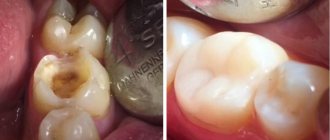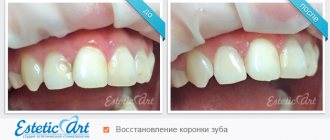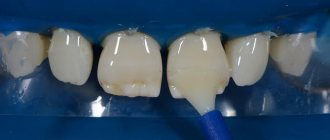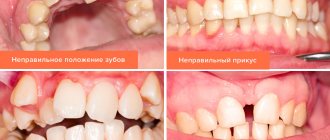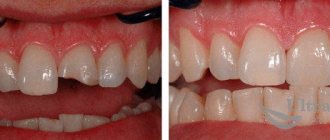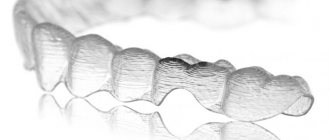The lateral and chewing teeth take the most active part in the process of biting and chewing food, and therefore crowns on chewing teeth should be installed from the most durable materials. Metal-ceramics are suitable as a prosthesis for the restoration of chewing teeth; the best metal crowns for chewing teeth are also widely used, allowing them to withstand the heaviest loads. A chewing tooth implant is usually made of titanium. For many patients, the aesthetic side of treatment is of paramount importance, especially when it comes to restoring the front teeth, while function fades into the background. This position cannot guarantee a long-term result, since if the functional component is violated, sooner or later the aesthetics begin to suffer. That is why modern restorative dentistry is aimed not only at creating ideal aesthetics, but also at completely restoring lost function.
Bridge prosthetics
The principle of installing a bridge is simple and known to many - adjacent teeth are ground down, a structure is made of three crowns - two “empty” and one solid in the middle. Empty crowns are used to cover ground teeth, and the structure is attached to dental cement. A full-bodied crown replaces a missing tooth in a row.
Advantages of the method: fast, inexpensive.
Disadvantages: traumatization of healthy teeth, since in most cases they need not only to be ground for a prosthesis, but also to be depulped. Injured teeth can soon cause new problems, and you will have to worry about restoring your dentition again.
Dental clinic No. 2
The use of composite materials to restore the shape and function of chewing teeth that have been subjected to various types of diseases, injuries and abrasion is becoming increasingly popular.
Recent studies have proven that the longevity of restorations depends not only on how the tooth is restored, but also on many other factors, such as: the patient's exposure to dental caries, the location of the tooth in the dentition, the patient's habits, the number of affected tooth surfaces, the quality of adhesion and the ability of the material to form a continuous connection at the restoration/tooth interface.
This means that successful restoration of distal teeth depends on the skill and experience of the doctor.
This article will review a clinical case of this procedure with the goal of creating a daily treatment protocol. This will allow the clinician to pay attention to many details when working with composite materials, avoid various technological errors and achieve high quality restorations.
This treatment protocol has 6 points:
Diagnostics and control of initial occlusal contacts Isolation and separation of adjacent teeth with wedges Modeling of the cavity and its finishing Restoration of contact points and occlusal surface Staining of fissures (optional) and imparting secondary and tertiary anatomy Grinding, polishing and alignment of occlusal relationships
Initial data: carious lesions located on both premolars and molars, the presence of old, unaesthetic and non-functional restorations to be replaced on teeth 1.6, 1.7
The existing occlusal contacts were checked using 40 micron thick articulating paper. This allows the doctor to determine how the teeth meet their antagonists in order to properly prepare and restore the tooth.
A rubber dam is used to isolate the working field. In cases of distal restorations, I prefer to apply it to the entire quadrant. This technique provides the doctor and his assistant with better visual and manual control during the treatment process. The teeth were cleaned with brushes, paste and airflow to remove plaque and dyes. This procedure is mandatory because it prevents contamination during subsequent stages of treatment.
Wedging the teeth even before starting preparation is a very important point because:
Provides protection for the proximal parts of the rubber dam from damage during preparation. The wedges move the rubber dam and gum more apically. Provides separation of teeth, which facilitates the preparation of their proximal surfaces.
The cavity modeling process includes three stages:
Providing access. Necroectomy. Creating a fold.
Most often, to create access to the cavity, I use a bur, the working part of which has the shape of a rounded cylinder with a diameter of 0.9 mm.
For necroectomy I use carbide burs in combination with a mechanical handpiece
I finish the cavity preparation by creating a rebate. This will ensure the future restoration has reliable integration with the dental tissues. For these purposes, it is important to use only low abrasive burs. At this stage, I prefer to use an Arkansas stone and a micromotor at low speeds. The main rule of cavity modeling is that the process should start at high speeds using water-air cooling and end at low speeds without water
Type of modeled cavities. Wedges were very useful in proximal preparations
The proximal wall was reconstructed using a metal matrix and ring. First I install the matrix, then the wedge, after which I use two small pieces of Teflon tape to better fit the matrix to the tooth, and then I secure it all with a V-ring
The matrix is in place. Also at this stage it is important to correctly select the height of the matrix in order to subsequently obtain the proximal ridge we need
Once we have restored the contact point, we can remove the matrix and begin creating the occlusal surface, guided by the original tooth anatomy
In the case of the second premolar, we used only a matrix, a wedge and a Teflon film. As mentioned above, the Teflon film provides a better fit of the matrix to the proximal surface of the tooth, and also helps the doctor fill the mesial cavity of the adjacent molar
Both premolars have been restored. At this point you can finish the restorations before working on the molars.
Matrix for molar. For the aesthetics of the future restoration, it is important that the height of the molar matrix corresponds in height to the proximal ridge of the premolar
View of the proximal ridges immediately after removal of the matrix and ring
For finishing I also prefer to use Arkansas stone, carbide burs and rubber discs. If desired, after this procedure you can apply paints to the occlusal surface. Here I used brown
Occlusal relationships were checked using 40 micron thick articulation paper. Both static and dynamic samples must be taken into account during this procedure
Final view of the restoration. Polishing was done using a cotton wheel, aluminum oxide paste and water. Using this protocol you can achieve excellent surface polishing
Author of the article: Dan Lazar
Removable dentures
Removable orthopedic structures can be made from various materials - nylon, acrylic, plastic with a metal base, etc. They can be used in cases where there is nothing to attach the bridge to, that is, to solve the problem of an end defect.
Advantages of the method: affordable price, no trauma to hard tissues or mucous membranes, the ability to correct the end defect.
Disadvantages: lack of comfort, long habituation, hygiene requires daily removal of the prosthesis and its cleaning outside the oral cavity, relatively short service life.
Methods
In dentistry, there are two methods of artistic restoration:
- direct way,
- indirect method.
Direct restoration is provided immediately at the time of the visit to the doctor; the time frame fits into one visit. For restoration, high-quality composite filling materials are used that match the natural shade of the enamel. Modern composite materials harden under the influence of light, have X-ray contrast, and are optimally suited for restoring the aesthetics and functionality of both anterior and posterior teeth.
The indirect method involves the use of lumineers, veneers or half-crowns. Before installation, the tooth is slightly ground down, then an impression is taken from it, which is then used to make the onlay.
The doctor determines the appropriate method depending on the problems to be solved and the clinical picture.
Classic implantation
If one tooth or several scattered defects are missing, you can use classic dental implantation. Its essence lies in the fact that an implant is surgically installed in place of the extracted tooth and takes root without any load. After complete engraftment, which is after 2-4 months for the lower jaw, and after 3-5 months for the upper jaw, the patient is given permanent prosthetics. It is important to choose strong and durable materials for prosthetics. So, for example, ceramics are not suitable for the chewing zone - they are aesthetic and very naturalistic in appearance; they will not withstand chewing loads for a long time. In this case, metal ceramics or zirconium dioxide are well suited as prostheses. Zirconium can be used on absolutely everyone, and metal ceramics can only be used on patients who do not have allergic reactions to metals.
Advantages of the method: reliability, durability, no trauma to other teeth in the row, absolute comfort in using dentures on implants.
Disadvantages: the need for surgical intervention, high cost compared to conventional prosthetics.
Prosthetics with crowns - on a pin or stump tab
If caries is not treated in time, sooner or later the pathological process will reach the pulp - the neurovascular bundle. The main characteristic symptom in this case will be acute pain. In such a situation, most often it is necessary to completely remove the nerve , clean and fill the canals, although sometimes in the early stages it is possible to relieve inflammation with medication.
If by the time you go to the doctor the tooth is already too badly damaged, then the restoration tab will not hold well. In such a situation, you can choose prosthetics with an artificial crown, and for the restoration of the distal parts, metal prostheses, metal-ceramics, zirconium or ceramic composite are usually chosen. It is important that the material is as durable as possible, even at the expense of aesthetics.
If the walls of the visible part of the tooth are preserved and the root is in satisfactory condition, the prosthetic procedure will be carried out in one of the following ways:
Source: dentalsolutions.ru
- with pin installation : to securely fix a single prosthesis, a pin is first inserted into the root canal. Today, strong, but at the same time quite elastic, fiberglass structures are more often used for this purpose, although a metal anchor pin can also be chosen for molars. The fiberglass product usually does not exceed 2 mm in diameter. In appearance, it is a thin matte rod, which becomes the connecting link between the root and the artificial crown,
- on a stump tab : unlike a restoration tab, this tab partially replaces the root system. This is a stronger and more reliable design, which is used when the coronal part is completely destroyed, but subject to the preservation of the root. The lower end of the product is inserted into the root canal, and the tip remains above the gum and serves as a support for the prosthesis.
Source: anzub.ru
Single-stage implantation
Separately, it is worth mentioning about one-stage dental implantation in the chewing zone. If at a dentist's appointment you hear a disappointing verdict that a tooth needs to be removed, do not rush to the surgeon's office. Find out from your dentist if there are any indications for immediate implantation in your case.
This is a protocol that is minimally invasive. The problematic tooth is removed and an implant is immediately inserted into the fresh socket. There is no need to cut the mucosa and apply stitches. In addition, one-stage implantation saves time, since the patient does not need to wait for the wound to heal after removal so that classical implantation can be done.
Advantages of the method: minimal trauma among all implantation protocols, reliability, longevity of the result.
Disadvantages: not suitable for all patients. If the bone tissue under the diseased teeth is destroyed or thinned out, it will not be possible to place an implant at once.
Types of composite material for high-quality dental restoration
The German-American composite composition Estet X is the optimal solution. A complete aesthetic dental restorative system, highly polishable, with the physical properties of the most sought after hybrid dental composites. The material for artistic restoration is distinguished by its sculptural plasticity, holds its shape, and is comfortable for the dentist to work with. Absolute naturalness as a result of composite dental restoration.
Filtek (Filtek) is a photopolymer material, a nanocomposite, which is often called a gel filling. Optimal material for high-quality restoration of chewing and anterior teeth. High strength, availability of multi-layer dental restoration, low shrinkage, wear resistance, the material can be polished well, a wide range of shades for dental restoration.
Doctors at the 32 Dent clinic perform high-quality aesthetic restoration of teeth using Estet X, Filtek materials, etc.
Lack of chewing teeth and impaired digestion
There is a direct connection between the presence of a full set of chewing teeth, bite and digestive organs. Having lost, along with the distant molars, the ability to chew food efficiently, a person significantly limits his diet and provokes the appearance of gastrointestinal diseases. A lack of nutrients will first affect the condition of the skin, hair and nails, and then the general condition of the body. And an overloaded digestive system will respond with the appearance of chronic diseases - gastritis, duodenitis, etc.
Malocclusion and pain in the spine
An unreplaced tooth violates occlusion - the correct physiological closure of the remaining teeth of the upper and lower jaw. Not immediately, but after a few years this will lead to the appearance of painful sensations - first in the temporomandibular joint, and then in the cervical spine, and, as a result, to regular headaches.
Our body is truly one whole. Therefore, a lower jaw displaced back or upper teeth protruding forward can cause the appearance of associated skeletal problems - from flat feet to scoliosis. This is well known to dentists and patients of orthodontic centers.
When a person finally wants to do implantation and install a denture on an artificial root, he will first have to correct the bite with braces or aligners.
Main types of dental restoration
1. Aesthetic (artistic) restoration – work with photopolymer filling material that imitates tooth tissue in color, transparency and texture. The doctor uses reflective gel composites and bonding so that the filling “sticks” with natural tissues during the artistic restoration process. This method of artistic restoration allows us to remove the following points:
- diastemas between dental units;
- unsightly tooth color;
- color stains on teeth.
2. Restoration to restore a tooth after mechanical damage - cracks, chipping of up to 1/3 of the crown, if the tooth has broken into two or more parts. The doctor restores the structural integrity of the dentin layer and enamel to create a new, whole and no different tooth.
3. Artistic composite restoration of the smile area is a piece of jewelry when it is necessary to bring the front group of teeth to perfection. When there are objective indications for such restoration, the dentist works with gel composites that restore the opaque, dentin layers and tooth enamel.
4. Restoration of chewing teeth - relevant when no more than a quarter of a molar or premolar tooth is chipped. Doctors use innovative composites with the addition of ceramics for strength, while visually they fully match the color and transparency of natural tooth enamel.
5. Composite restoration to straighten crooked teeth. A more affordable and relatively quick alternative to orthodontic treatment. The convenient method of composite restoration allows you to correct minor changes using filling material.
Frequently asked questions about composite restorations
- What determines the success of dental restoration?
From the quality of the chosen material for restoration, the qualifications of the doctor. Before choosing a specialist in the field of restoration, familiarize yourself in detail with his work and reviews. - Are there any contraindications for dental restoration?
In general, there are almost no disadvantages to the restoration. With the exception of complex diseases of organs and blood. - Is it possible to resort to artistic composite dental restoration if patients want the “Hollywood smile” effect, but are not ready to spend money on ceramic veneers?
Yes, you can. At a free preliminary consultation, the dentist will determine the number of teeth that need restoration.
When is tooth restoration required?
The procedure is carried out for two main indications: medical and aesthetic. In the first case, this is necessary so that the neighboring ones do not become loose, so that food can be fully chewed, and also to prevent bone atrophy, because in the absence of load on it, there is a decrease in bone function and its thinning.
If the patient wishes, the smile and ease of eating are restored, discomfort when communicating with people is eliminated, which can be caused by the feeling that they notice a defect and mentally do not want to communicate with anyone.
Implantation and prosthetics of the upper front teeth – photos and prices in Minsk
Restoring the aesthetics of the upper anterior teeth is perhaps the most common problem, requiring an integrated approach and coordinated work of an implant dentist and an orthopedic dentist.
Prosthetics for anterior teeth are most often performed with metal-free ceramics on a zirconium dioxide frame. The price in Minsk for such crowns varies from 300 to 400 dollars per unit. It is worth considering that the cost of the zirconium inlay (up to $100) must also be included in the work. The need to use an inlay is determined by an orthopedic dentist.
In addition, in 60% of cases it may be necessary to treat or re-treat the root canals. The cost depends on the number of canals in the tooth. Of course, it is very difficult to say the exact price for such work without seeing the patient. However, it is possible to receive a remote consultation and treatment plan by sending us a panoramic photo of your teeth. See photos of prosthetic options for the upper front teeth below.
When implanting the upper front teeth, the dentist’s attention is more focused on restoring aesthetics. But at the same time, the front teeth must be strong in order to perform the function of biting without problems. Remember how much effort you put in when you bite off, for example, a carrot or an apple!
It is very important that the patient has sufficient bone tissue in the area of the upper front teeth. If there is enough bone, then the implementation of an aesthetic orthopedic design on implants is ensured (of course, subject to the skillful hands of an orthopedic dentist). If there is not enough bone, then it would be more correct to first perform bone grafting or lifting (only after consulting an implantologist!). The cost of implanting anterior teeth is no different from the cost of installing implants in the chewing areas. But in the anterior section, to improve aesthetics, in 95% of cases a temporary crown is installed on a temporary abutment (cost $60-80). Installation of a temporary crown can be performed in one step in approximately 1 – 1.5 hours. See photos of options for implanting upper front teeth below.

